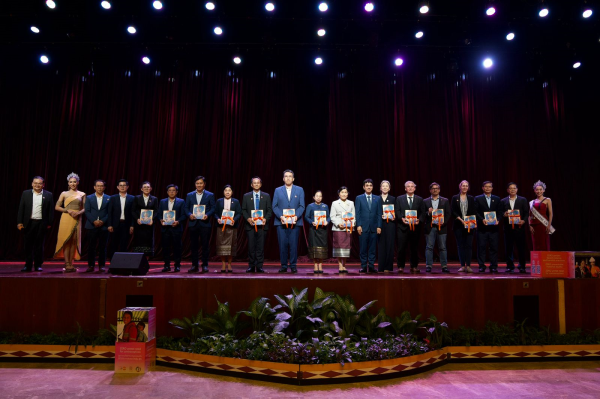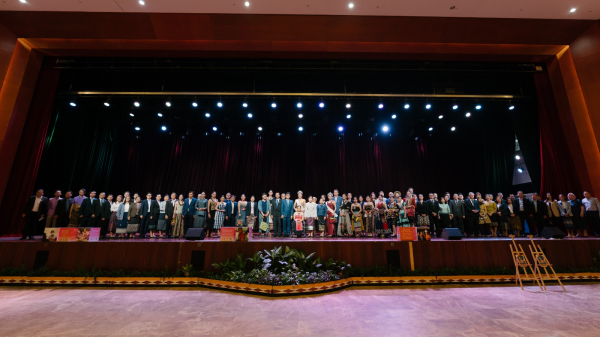
(KPL) Representatives from government, embassies, development partners, civil society, media, private sector, and young people all came together to celebrate World Population Day and raise awareness and support for the Lao PDR’s commitments from the 7th Asia Pacific Population Conference and the 57th Commission on Population and Development.
Held in Vientiane on July 9, the meeting sought to engage stakeholders in support of accelerating the implementation of the Programme of Action of the International Conference on Population and Development.
Deputy Minister of Planning and Investment (MPI), Ms Phonevanh Outhavong, and Bakhtiyor Kadyrov, the United Nations Population Fund (UNFPA) Representative to the Lao PDR, led the celebrations emphasizing the importance of World Population Day in increasing awareness of national progress and commitments, sharing success stories, and learning from best practices to accelerate the ICPD Programme of Action.
Ms. Phonevanh Outhavong remarked on the importance of investment on young people.
She called on the central and local sectors as well as all sectors of society to continue to implement various programmes and policies of the Lao PDR, as well as to consider to plan and utilize the various potentials in the country.

“There is an urgent need to increase and strengthen cooperation with various strategic partners including development partners. In particular, we would maximize harnessing the demographic dividend and potential strength of young people who account for 60% of the total population. We need to ensure that our young people are well equipped with good education, skills, health, employment and empowered to make an important contribution to the development of Laos,” said Ms. Phonevanh.
This year’s marking of the World Population Day in the country gets insights from the State of World Population Report “Weaving the promise: Ending Inequalities in Sexual and Reproductive Health and Rights.
The celebration is to demonstrate that family, community and national resilience comes not from any individual strand but emanates from the collective, interwoven whole.
The event included textile fashion show and performance with key messages.
UNFPA Representative Bakhtiyor Kadyrov applauded the Lao PDR for its strong commitment to the ICPD PoA.
“Thirty years ago, at the International Conference on Population and Development (ICPD) governments around the world agreed that reproductive health and rights are the foundation stones of global development – paving the way for decades of progress in realizing rights and choices,” said Kadyrov.
In 1994, the Lao PDR was one such government that embraced this landmark Programme of Action at the ICPD in Cairo, followed by adopting progressive national population policies, strategies, laws and related action plans to empower women, men, girls and boys.

National efforts have primarily focused on placing people at the heart of development. Since the Cairo conference in 1994, which represented a significant shift away from population control policies and towards prioritizing the rights, choices and people's well-being, the Lao PDR has made notable progress in advancing sexual and reproductive health, gender, rights, human capital and life expectancy.
During the celebration, the Lao government and UNFPA showcased successful programmes from the past year, promoting universal access to sexual and reproductive health, realizing reproductive rights, reducing maternal mortality, and empowering women and young people, ensuring no one is left behind.
Over the years of strong partnership, the Lao government and UNFPA have supported initiatives to enhance data availability and accessibility on population characteristics, including civil registration, vital statistics, the demographic dividend, population censuses, surveys, and research. This effort has facilitated the development of inclusive population policies and the integration of sexual and reproductive health, reproductive rights, and gender into sectoral programmes.
Stakeholders highlighted the Lao PDR's significant achievements, including reducing the proportion of people living below the national poverty line from 48% in 1990 to 18.3% in 2018-2019. They also noted a decline in maternal mortality from 905 per 100,000 live births in 1990 to 126 per 100,000 live births in 2020, with 79.8% of births attended by skilled personnel.
Although significant strides have been made in the past three decades, disparities persist across ethnic groups, geographic regions, ages, and socio-economic backgrounds. A critical indicator highlighted by the new data from LSIS III refers to SDG 5.6.1 which recognizes the importance of bodily autonomy as a human right.
The data shows that only around 18% of women take autonomous decisions regarding contraceptive use, and only 45% can make their own decisions regarding healthcare. This is further exacerbated with disparities among urban and rural communities (especially those without road access) and by age, ethnicity, and region.

As the demographic landscape shifts towards a larger proportion of working-age women, our attention on young girls and women becomes increasingly critical, especially regarding issues like teen pregnancies and child marriage. Bokeo Province, for instance, faces a staggering teenage pregnancy rate of 27%, more than double the global average.
Regarding child marriage, over half of Laos' poorest women are married before turning 18—five times more than their wealthiest counterparts. Education emerges as pivotal; girls without education experience childbearing rates over eight times higher than those with higher educational attainment.
The proceedings illustrated how gender equality is a pivotal development investment, yielding substantial social and economic benefits, and how significant returns can be achieved through rights-based family planning, reducing unintended pregnancies, improving educational outcomes, increasing lifetime earnings for girls, and enhancing women's workforce participation. It was also noted that one third of the economic growth experienced in Asia during the demographic dividend years has been attributed to improvements in women’s empowerment and their participation in the labour force alongside rapid fertility transition.
The day’s programme also underscored ongoing challenges exacerbated by disparities among ethnic groups, geographic areas, age, and socio-economic status. Stakeholders emphasized the critical need for continued investment in data to identify and empower marginalized groups.
This year's celebration further emphasized the transformative impact of inclusive data generation and the importance of the upcoming Lao Population and Housing Census to generate robust data on socio-economic characteristics to inform planning processes aimed at achieving the three zeros of ending preventable maternal deaths, ending the unmet need for family planning and ending gender-based violence as well as all harmful practices, including child marriage.